When it comes to driving traffic to your website, two significant players in the digital marketing world are Search Engine Optimization and Pay Per Click. While both strategies aim to boost your online presence, they take vastly different approaches to achieve that goal.
So, SEO vs PPC? Pros, Cons, Differences, and which one to choose for your business? In this article, we’ll break down the basics of each technique and help you determine which approach is best suited to your unique needs and goals.
Before delving into the details, this article will provide you with an overview of the fundamentals. Once you have a grasp of the basics, you will be able to determine which option is more suitable for your business needs.
Table of Contents
What is the difference between SEO and PPC?
What is search engine optimization (SEO)?
Pros and Cons: SEO
What is Pay Per Click (PPC) Advertising
Pros and Cons: PPC
How is ranking different when comparing ppc vs seo?
Is it Good to Use PPC and SEO at the Same Time?
To Sum Up…
What is the difference between SEO and PPC?
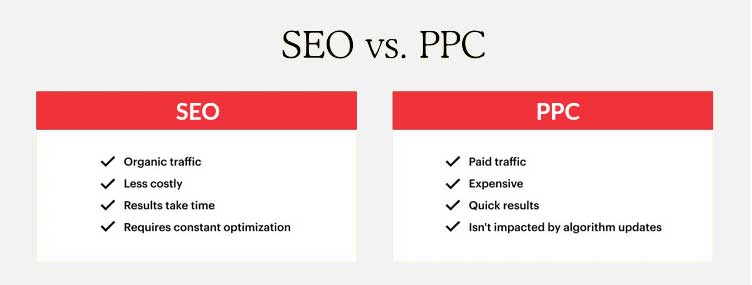
SEO (Search Engine Optimization) vs PPC (Pay-Per-Click) are two distinct online marketing strategies used to increase visibility and drive traffic to websites.
While both SEO vs Pay Per Click advertising aim to improve website visibility on search engines, they differ in terms of their approach, cost, and results. Here’s a breakdown of their differences with examples:
Approach:
SEO: It involves optimizing a website and its content to improve organic (unpaid) search engine rankings.
SEO enhances various on-page and off-page factors such as website structure, keyword usage, content quality, backlinks, and user experience. The goal is to rank higher in search engine results pages (SERPs) to attract organic traffic.
- Example: A business owner uses SEO techniques to optimize their website’s content, and metadata, and acquire high-quality backlinks to improve its search engine rankings for relevant keywords.
- This increases the chances of appearing in the top organic results when users search for related terms.
PPC: It is a paid advertising model where advertisers pay each time their ad is clicked. Advertisers bid on keywords, and when a user searches for a keyword, the ads related to that keyword are displayed prominently in search engine results.
Advertisers only pay when someone clicks on their ad.
- Example: A company creates a PPC campaign on Google Ads and bids on relevant keywords such as “buy smartphones online.”
- When users search for that keyword, the company’s ad appears at the top of the search results. If a user clicks on the ad, the company pays a predetermined cost per click.
Cost:
SEO: While SEO requires effort and resources to optimize a website and generate quality content, the actual cost of appearing in organic search results is relatively lower.
However, the process of achieving higher rankings organically can be time-consuming and may require ongoing efforts.
PPC: pay-per-click optimization involves a cost-per-click model, where advertisers pay for each click on their ads.
The cost depends on various factors like keyword competitiveness and quality score. Advertisers have control over their budgets and can set daily spending limits. PPC can generate immediate results but requires a higher budget compared to SEO.
Google’s Organic vs Paid Results
Google’s search engine results pages (SERPs) display two types of results: organic search vs paid search
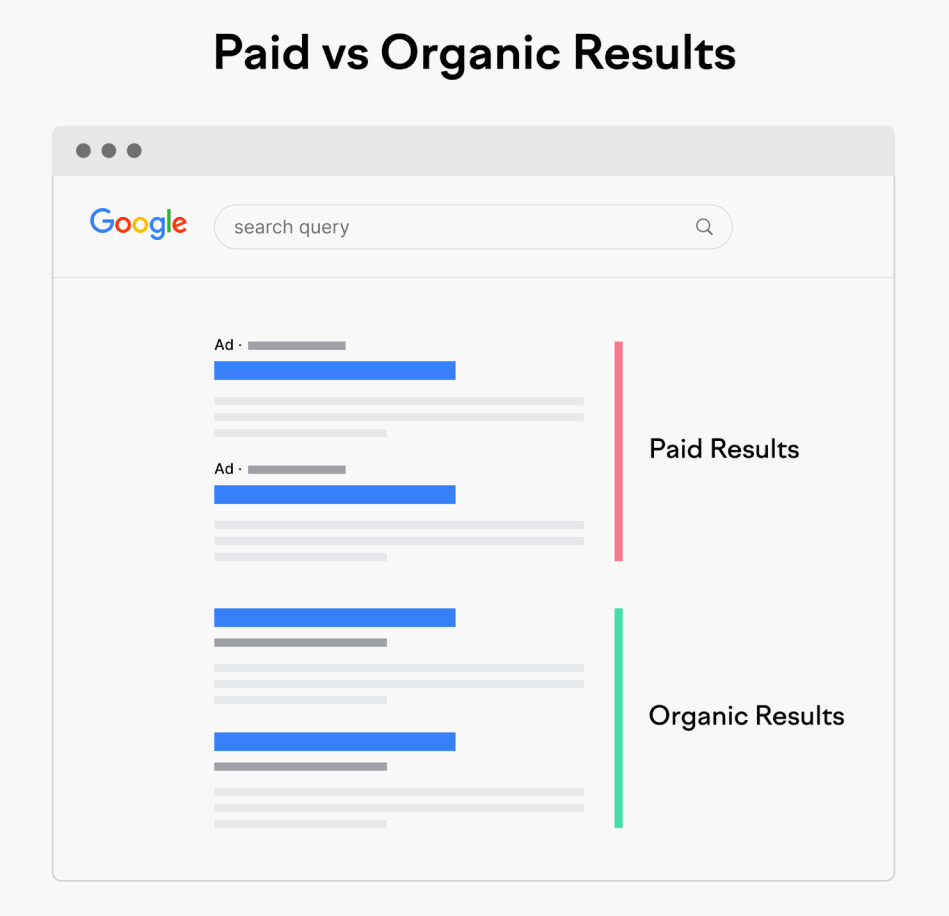
Organic results are the listings that appear naturally on the SERP based on their relevance and authority for a specific search query. These results are not paid for, and Google’s algorithm determines their ranking. Organic results are displayed in the main body of the SERP, usually below any paid results or ads.
For example, if someone searches for “shoes for women,” Google will display a list of organic results that it determines to be the most relevant and authoritative for that particular search query. These results are based on factors such as the website’s content, backlinks, and overall user experience.
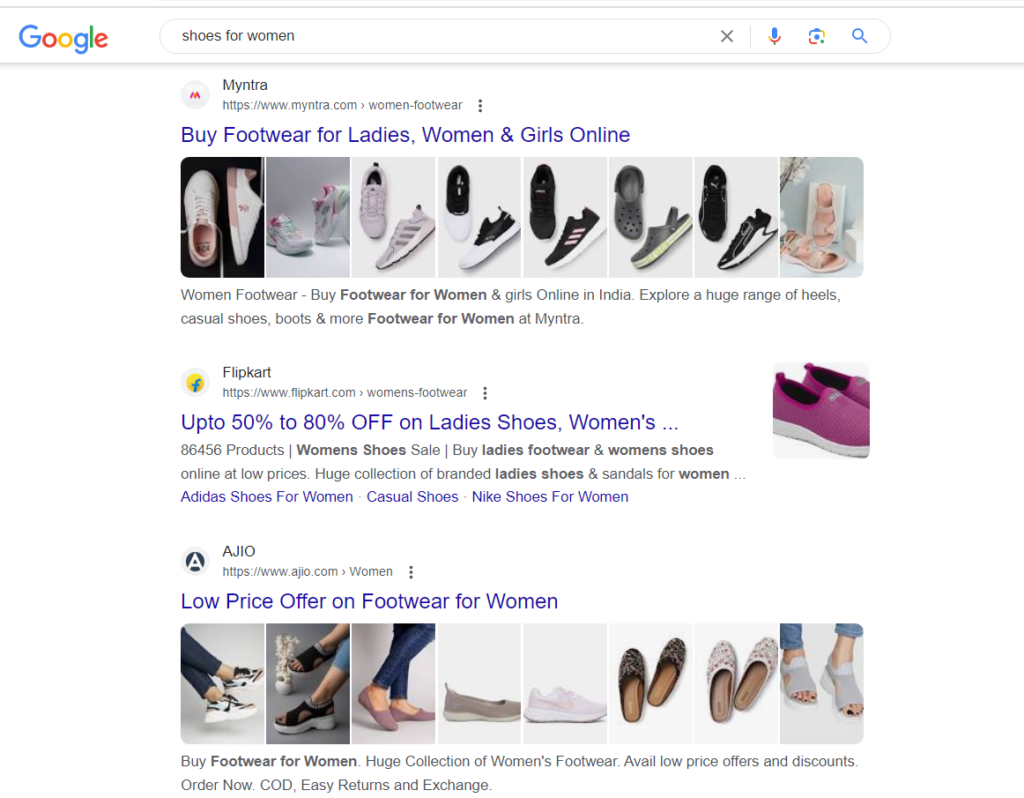
Paid results, also known as pay-per-click (PPC) advertising, are listings that businesses pay for to appear at the top or side of a SERP. Advertisers bid on specific keywords or phrases, and when a user searches for those terms, the ads are displayed.
Advertisers are charged a fee each time someone clicks on their ad.
For example, if an online jewellery website wants to attract more customers, it can create a PPC ad campaign targeting the keywords “gold jewellery with price.”
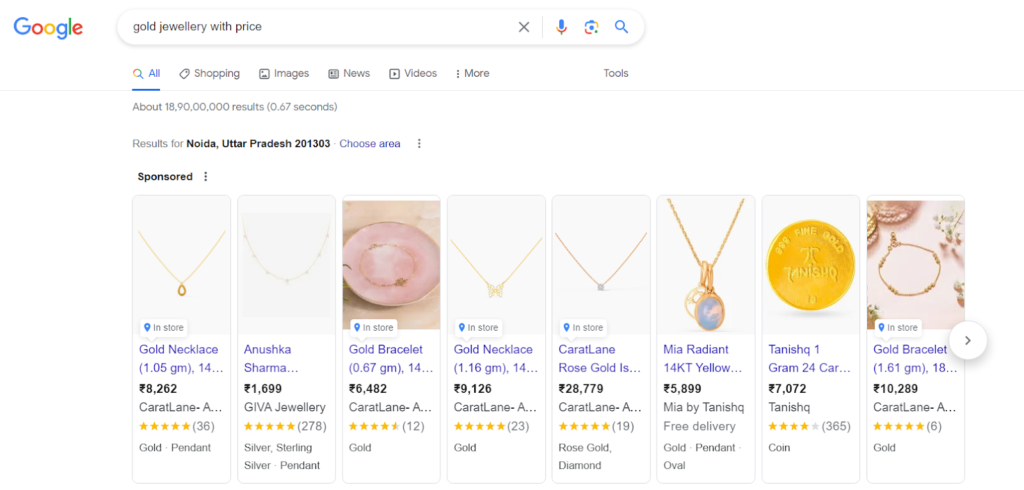
Their ad will appear at the top of the SERP, above the organic results, when someone searches for that keyword. Also, the word “SPONSORED” above the advertisement also indicates that it is a paid result. The online store will be charged each time someone clicks on their ad and is directed to their website.
Thus, organic results are non-paid, natural listings that appear on a SERP based on their relevance and authority, whereas paid results are listings that advertisers pay for and appear at the top or side of a SERP.
What is search engine optimization (SEO)?
Search Engine Optimisation is the practice of optimizing a website to improve its visibility and ranking on search engine results pages (SERPs) for specific keywords and phrases.
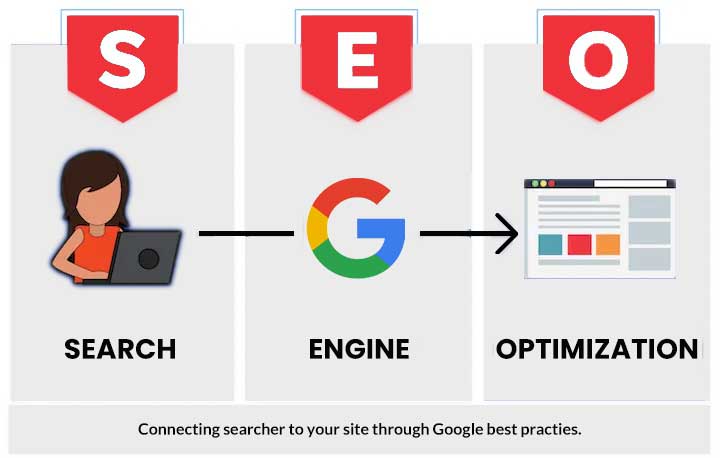
SEO aims to drive organic, or non-paid, traffic to a website and improve the website’s overall online presence.
- optimizing website content,
- using relevant keywords and phrases,
- building high-quality backlinks,
- and improving website structure and navigation.
By implementing these strategies, a website can increase its relevance and authority in the eyes of search engines, which can lead to higher rankings on SERPs.
Keyword Research:
Keyword research involves using various tools and techniques to identify the keywords and phrases that are most relevant and popular for a particular industry or topic. This includes analyzing search volume, competition, and user intent to determine which keywords are worth targeting.
Once the keywords are identified, they are used to optimize website content, including page titles, meta descriptions, headers, and body text.
By integrating pertinent keywords into their website content, organizations can boost their significance and expertise for those keywords. This, in turn, can result in an improvement in their ranking on search engine results pages (SERPs).
Keyword research is an ongoing process, as search trends and user behaviour change over time. By regularly analyzing keyword performance and adjusting website content accordingly, businesses can ensure they are staying relevant and meeting the needs of their target audience.
Technical SEO
It refers to the process of improving a website’s technical features in order to enhance its appearance and position on search engine results pages (SERPs).
This encompasses enhancing the website’s back-end framework and structure, including elements such as the code, speed of the website, adaptability to mobile devices, and the ease with which search engine crawlers can explore the site.
Some examples of technical SEO include:
- Website speed optimization: Ensuring that a website loads quickly and efficiently to improve user experience and search engine rankings.
- Efficient management of the crawl budget holds significant importance as it allows search engines to prioritize crawling and indexing the crucial and pertinent pages of a website.
- Mobile responsiveness: Ensuring that a website is optimized for mobile devices, as more people are using smartphones and tablets to access the internet.
- XML sitemaps: Creating XML sitemaps to help search engines understand the structure and organization of a website’s content.
- HTTPS: Securing a website with HTTPS to protect user data and improve search engine rankings.
- Structured data: Implementing structured data markup to provide additional information to search engines and improve the visibility of a website’s content on SERPs.
Technical SEO is important because it helps search engines crawl and index a website more effectively, which can improve its visibility and ranking on SERPs.
By optimizing a website’s technical aspects, businesses can improve their online presence and attract more organic traffic to their website.
On-page SEO
On-page SEO, also known as on-site SEO, refers to the practice of optimizing individual pages on a website to improve their relevance and authority for specific keywords and phrases. On-page SEO involves optimizing various on-page elements, such as content, HTML tags, and images.
Here are some examples of on-page SEO:
- Keyword research and optimization: Conducting keyword research to identify relevant and popular keywords and phrases, and optimizing the content on each page to include those keywords.
- Title tags and meta descriptions: Creating unique, descriptive, and keyword-rich title tags and meta descriptions to improve click-through rates and search engine rankings.
- Content optimization: Creating high-quality, relevant, and engaging content that satisfies the user’s search intent and provides value to the user.
- Header tags: Using header tags (H1, H2, H3, etc.) to structure the content on a page and make it easier to read and understand.
- Image optimization: Optimizing images by using descriptive file names, alt tags, and captions to help search engines understand the content of the image.
- Internal linking: Creating internal links between pages on the website to improve navigation and help search engines understand the structure and hierarchy of the website.
On-page SEO is important because it helps search engines understand the content and relevance of each page on a website. By optimizing on-page elements, businesses can improve their search engine rankings and attract more organic traffic to their website.
Off-page SEO:
Off-page SEO encompasses the techniques and actions that happen externally to a website with the goal of advancing its appearance and position on search engine results pages (SERPs).
This includes creating superior and appropriate connections from other sites to boost the credibility and dependability of a website from the perspective of search engines.
Here are some examples of off-page SEO:
- Link building: Building high-quality backlinks from other authoritative and relevant websites to improve the authority and trustworthiness of a website.
- Social media marketing: Promoting a website and its content through social media channels to increase brand awareness, engagement, and website traffic.
- Influencer outreach: Building relationships with industry influencers and bloggers to promote a website and its content to a wider audience.
- Guest blogging: Writing high-quality and relevant blog posts for other websites and including a link back to the website to improve its visibility and authority.
- Online reputation management: Monitoring and managing a website’s online reputation by responding to reviews, comments, and feedback on various online platforms.
Off-page SEO is important because it helps search engines understand the popularity and relevance of a website beyond its own content
Content:
SEO plays a significant role in content creation and marketing. It helps ensure that your content is visible, relevant, and optimized for search engines.
- Visibility in Search Results: it helps your content appear in search engine results pages (SERPs) when users search for relevant keywords.
By optimizing your content with targeted keywords, search engines can better understand the topic and relevance of your content, increasing its visibility. When your content ranks higher in search results, it has a higher chance of being discovered and accessed by users.
- Increased Organic Traffic: When your content ranks well in search results, it attracts more organic traffic. Organic traffic refers to visitors who find your website through unpaid search results.
SEO helps optimize your content to target specific keywords and search queries that align with your target audience’s interests and needs. By appearing in relevant search results, you can drive more organic traffic to your content.
- Targeted Audience Engagement: it helps you understand your target audience’s search behaviour and preferences. Through keyword research and analysis, you can identify the topics, questions, and concerns your audience is searching for.
By creating content that addresses their needs and provides valuable information, you can attract and engage your target audience. SEO ensures that your content aligns with the search intent of your audience, increasing the likelihood of engagement and conversions.
- Authority Building and Backlink Acquisition: it contributes to building your website’s authority and credibility. When your content is optimized and provides valuable information, it is more likely to be linked to and shared by other websites.
Backlinks from authoritative sources signal to search engines that your content is trustworthy and valuable. By earning backlinks, you enhance your website’s authority, which positively impacts your overall SEO performance.
- Long-Term Value: Content optimized for SEO can provide long-term value. Unlike paid advertising campaigns, SEO-driven content continues to attract organic traffic over time without ongoing expenses.
Once your content ranks well and gains visibility, it can generate consistent traffic and leads. SEO ensures that your content remains discoverable and relevant in search results, continuing to drive value long after it is published.
- Content Optimization for Featured Snippets: Structure your content to provide concise and well-organized answers to commonly asked questions in your industry. This increases the chances of your content being featured in rich snippets, which can improve visibility and drive more organic traffic to your website.
Pros and Cons: SEO
Are you considering investing in SEO? Let’s examine the advantages and disadvantages of this marketing approach.
Pros:
- Organic Traffic:
SEO helps to drive organic traffic to your website, meaning that people are finding your website through search engines without you having to pay for ads. This traffic can be more valuable than paid traffic, as users are actively searching for your product or service.
- Long-term Results:
SEO is a long-term strategy that can help your website rank higher in search engine results pages (SERPs) over time. This means that you can continue to see benefits from your SEO efforts long after you’ve invested time and resources into your campaigns.
- Cost-effective:
Unlike PPC advertising, SEO does not require a significant financial investment to see results. While there may be costs associated with hiring an SEO expert or creating content, these costs are often lower than the cost of running a PPC campaign.
- Trust and Credibility:
Ranking higher in search results can help to establish trust and credibility with potential customers. When users see your website ranking high in SERPs, they may be more likely to trust your brand and click through to your site.
Cons:
- Time-consuming:
SEO can be a time-consuming process, especially if you’re just starting out. It can take weeks or even months to see results, and ongoing efforts are required to maintain your rankings.
- Constantly changing:
Search engine algorithms are constantly changing, which means that SEO best practices are constantly evolving. This means that you need to stay up-to-date with the latest trends and strategies to stay competitive.
- Competition:
SEO is a highly competitive field, especially for popular keywords and industries. This means that it can be difficult to rank high in search results without investing a significant amount of time and resources.
- Uncertainty:
There is no guarantee that your SEO efforts will lead to increased traffic or sales. While SEO can be effective, there are many factors that can impact your rankings, including changes in search engine algorithms, new competitors entering the market, and changes in user behaviour.
What is Pay Per Click (PPC) Advertising
Pay-per-click (PPC) is an advertising model in which advertisers pay a fee each time their ads are clicked. Essentially, it is a way of buying visits to your website rather than trying to earn those visits organically.

Here are some examples of PPC advertising:
- Search engine advertising: One of the most common forms of PPC advertising is search engine advertising.
This involves bidding on keywords relevant to your business and creating ads that will appear at the top of search engine results pages (SERPs) when those keywords are searched by users.
For example, when you search for “buy shoes online,” you might see ads from online shoe retailers at the top of the page.

- Social media advertising: Social media platforms like Facebook, Instagram, Twitter, and LinkedIn also offer PPC advertising options.
Advertisers can create ads that will appear in users’ feeds based on their interests, demographics, and behaviours.
For example, a clothing brand might target its ads to women aged 18-35 who have shown an interest in fashion.
- Display advertising: Display advertising involves placing ads on websites that are relevant to your business. These ads can be in the form of banners, videos, or text ads. Advertisers can target specific websites or use ad networks to reach a wider audience.
For example, a travel company might place ads on websites related to travel or tourism.
- Remarketing: Remarketing is a form of pay per click advertising that targets users who have already visited your website or interacted with your brand in some way. By using cookies or tracking pixels, advertisers can show ads to these users as they browse the web.
For example, a clothing retailer might show ads to users who have visited their website but didn’t make a purchase.
PPC advertising is beneficial for businesses because it can generate immediate results and provides a high degree of control over ad targeting and spending.
By using PPC advertising, businesses can reach their target audience more effectively and drive more traffic to their website, leading to increased conversions and revenue.
Here are the steps involved in setting up a PPC campaign on Google Ads:
Keyword research:
The first step in creating a successful PPC campaign is to conduct keyword research.
This involves identifying the keywords and phrases that are relevant to your business and that people are searching for. You can use Google’s Keyword Planner tool to find keywords and estimate their search volume.
Keyword research in PPC involves several steps, including:
- Brainstorming: The first step is to brainstorm a list of potential keywords that people might use to find your products or services. This can include keywords related to your industry, your brand, and your target audience.
- Keyword analysis: Once you have a list of potential keywords, you can analyze each keyword to determine its search volume, competition level, and cost per click (CPC).
This can be done using a keyword research tool like Google’s Keyword Planner.
- Keyword selection: Based on the analysis, you can select the keywords that are most relevant to your business and have the highest potential for driving clicks and conversions.
- Keyword grouping: Once you have selected your keywords, you can group them into ad groups based on their relevance and similarity.
This helps to ensure that your ads are highly targeted and relevant to each keyword group.
Writing ad copy:
The next step is to write ad copy that is relevant to your target audience and includes your target keywords.
Google Ads allows you to create multiple variations of ad copy, which can be tested to determine which ones perform best.
Creating campaigns and ad groups:
Once you have identified your target keywords, you can create campaigns and ad groups in Google Ads.
A campaign is a set of ad groups that share a budget and targeting options, while an ad group is a set of ads that share a set of keywords and a bid.
Setting bids:
You will need to set bids for your target keywords, which determine how much you are willing to pay for each click on your ad.
Google Ads uses an auction system, so your bid will compete with other advertisers’ bids for the same keywords.
Launching your campaign:
Once your campaigns and ad groups are set up, and your ad copy and bids are in place, you can launch your PPC campaign on Google Ads.
Your ads will start appearing on Google’s search results pages and on websites that are part of the Google Display Network.
Monitoring and optimizing your campaign:
To ensure the success of your PPC campaign, you will need to monitor its performance regularly and make adjustments as needed.
You can use Google Ads’ reporting and analytics tools to track key metrics such as click-through rate, cost per click, and conversion rate, and adjust your bids and ad copy to improve performance.
Pros and Cons: PPC
Are you considering investing in PPC? Here are the advantages and disadvantages to help you make an informed decision.
Pros:
- Targeted Advertising:
Pay-per-click advertise allows you to target specific audiences based on demographics, location, interests, and other factors. For example, if you sell yoga mats, you can target people who have shown an interest in yoga or fitness.
- Instant Results:
With pay-per-clicks, you can see results quickly, often within hours of launching your campaign. This is especially useful for businesses that need to generate leads or sales quickly.
- Control Over Spending:
You can set a budget for your campaigns, and only pay for clicks or conversions. This gives you greater control over your spending and ensures that you don’t overspend on your advertising.
- Measurable Results:
PPC offers detailed analytics and reporting, allowing you to track the performance of your campaigns in real-time. This lets you see what’s working and what’s not, so you can adjust your strategy accordingly.
Cons:
- Cost:
PPC can be expensive, especially if you’re bidding on competitive keywords. This means that you may need to invest a significant amount of money to see results.
- Competition:
Because PPC is so popular, there is a lot of competition for ad space. This means that you may need to bid higher on keywords to get your ads seen, which can drive up your costs.
- Ad Fatigue:
Over time, users may become fatigued with seeing the same ads repeatedly, leading to ad blindness and decreased click-through rates. This means that you may need to create new ad creative or change your strategy to keep your campaigns fresh.
- Click Fraud:
Click fraud is a type of fraud in which malicious users or bots click on ads to exhaust a competitor’s budget. This can lead to wasted ad spend and decreased ROI.
How is ranking different when comparing ppc vs seo?
PPC (Pay-Per-Click) vs SEO (Search Engine Optimization) are two distinct methods of increasing a website’s visibility on search engine results pages (SERPs) and driving traffic to the site.
PPC involves creating and running ads on search engines, where the advertiser pays a fee each time someone clicks on their ad. PPC ads appear at the top of the search engine results page and are marked as ads. The ranking of PPC ads is determined by the amount an advertiser bids on a keyword and their ad’s quality score, which is based on the relevance of the ad to the search query, the landing page experience, and other factors.
SEO, on the other hand, involves optimizing a website’s technical aspects, content, and off-page factors to improve its ranking on SERPs organically.
The ranking of SEO results is determined by the relevance and authority of the website’s content, the quality and quantity of backlinks pointing to the site, and other factors such as website speed, mobile responsiveness, and user experience.
Thus, PPC ads appear at the top of the SERPs and are ranked based on bidding and quality score, while SEO results appear below the ads and are ranked based on relevance and authority.
PPC ads provide immediate results but require ongoing investment, while SEO requires more time and effort to produce results but can provide long-term benefits and sustained traffic.
Is it Good to Use PPC and SEO at the Same Time?
When it comes to choosing between SEO vs Pay-Per-Click (PPC) advertising, there is no one-size-fits-all answer. Each has its own advantages and disadvantages, and the best choice depends on the specific needs and goals of your business.
Using both SEO vs. PPC together can be an effective strategy to drive traffic and increase visibility for your content. Here are some ways to use both SEO and PPC for your content:
- Increased Visibility:
By utilizing both SEO vs PPC, you can appear in multiple locations on search engine results pages (SERPs). With SEO, you can target organic search results and rank higher for relevant keywords.
Simultaneously, PPC ads allow you to occupy the paid ad space at the top of the SERPs. This increases your visibility and makes it more likely for users to notice and click on your website.
- The Synergy between Organic and Paid Results:
Studies have shown that when a website appears in both the organic and paid sections of search results, it can enhance brand visibility, credibility, and click-through rates.
Users are more likely to perceive your website as authoritative when they see it appearing both as an organic search result and a paid ad. This synergy can lead to higher overall click-through rates and better chances of capturing user attention.
- Targeting a Wider Range of Keywords:
Both SEO vs PPC offer different keyword targeting opportunities. With SEO, you can focus on optimizing your website for a broader range of long-tail and informational keywords, as it can be challenging to rank organically for highly competitive keywords.
PPC, on the other hand, allows you to bid on competitive keywords and instantly gain visibility for those terms. By utilizing both strategies, you can target a wider range of keywords and ensure comprehensive coverage across various search queries.
- Data Insights and Testing:
PPC campaigns provide valuable data and insights that can benefit your overall digital marketing efforts. By running PPC campaigns, you can gather information about which keywords, ad copy, and landing pages perform well in terms of generating clicks, conversions, and engagement.
Both SEO vs PPC campaigns can be used for these insights to optimize your SEO strategy, including optimizing your website content and targeting keywords based on actual performance data.
- Immediate Results and Flexibility:
PPC campaigns can generate immediate results and provide flexibility in terms of targeting, budget allocation, and ad messaging.
This can be particularly useful when launching new products, promoting limited-time offers, or during seasonal marketing campaigns.
While SEO is a long-term strategy, PPC can complement it by delivering instant traffic and results while waiting for SEO efforts to take effect.
To Sum Up…
By combining both of these two approaches SEO vs. PPC, you can maximize your reach, target your audience more effectively, and increase your chances of success.
So, why choose between SEO vs. PPC when you can have the best of both worlds? Start integrating these strategies today and watch your content soar to new heights!
